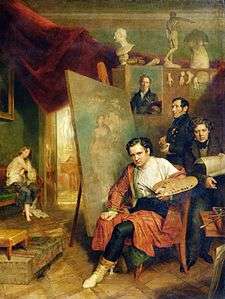Wilhelm August Golicke

Wilhelm August Golicke (Russian: Вильгельм-Август Голике, also Василий Александрович Голике. 1802, Tallinn or Saint Petersburg - 5 July 1848, Saint Petersburg) was a Baltic German painter.
Life and paintings
He grew up in the German community of Tallinn ("Reval", in German),[1] and studied in Saint Petersburg at the studios of the English painter George Dawe.
Between 1822 and 1828 Dawe, together with Golicke and another of his students, Alexander Polyakov (1801-1835), a serf, painted 332 portraits of Tsarist Generals who had distinguished themselves in the war against Napoleon.[1] The paintings were placed in the Military Gallery of the Winter Palace. Dawe became a good friend of Golicke's during their work together and left him an annuity in his will.[2]
After Dawes' death, Golicke studied at the Imperial Academy of Arts. He graduated in 1832 and was named an "Independent Artist" (Cвободный Xудожник), a sign of official recognition.[2] In 1837, he visited England and Italy. He died in Saint Petersburg, of cholera, in 1848.[1]
His post-Dawe work consisted largely of genre paintings, still-lifes and scenes from history. Many of his works can be seen at the Tretyakov Gallery in Moscow.
References
| Wikimedia Commons has media related to Wilhelm August Golicke. |
External links
- PetroArt: Brief ungrammatical biography of Golicke with link to portraits.
- AskArt: "The Fruit Seller" and "The Fisherman", by Golicke